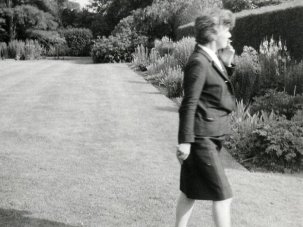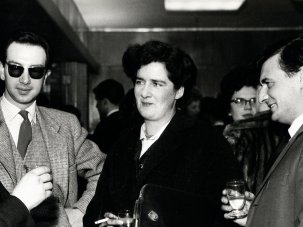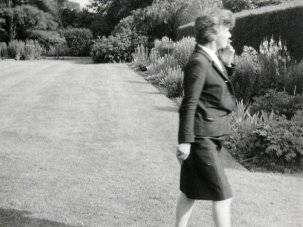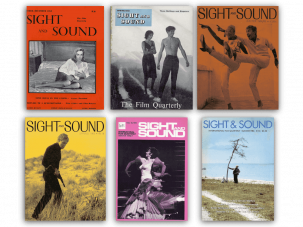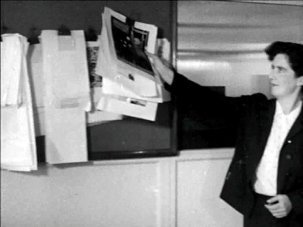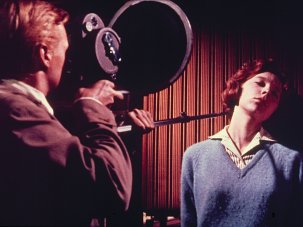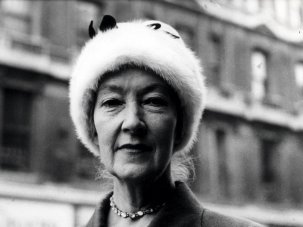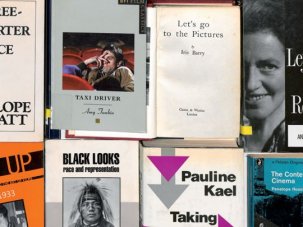Web exclusive
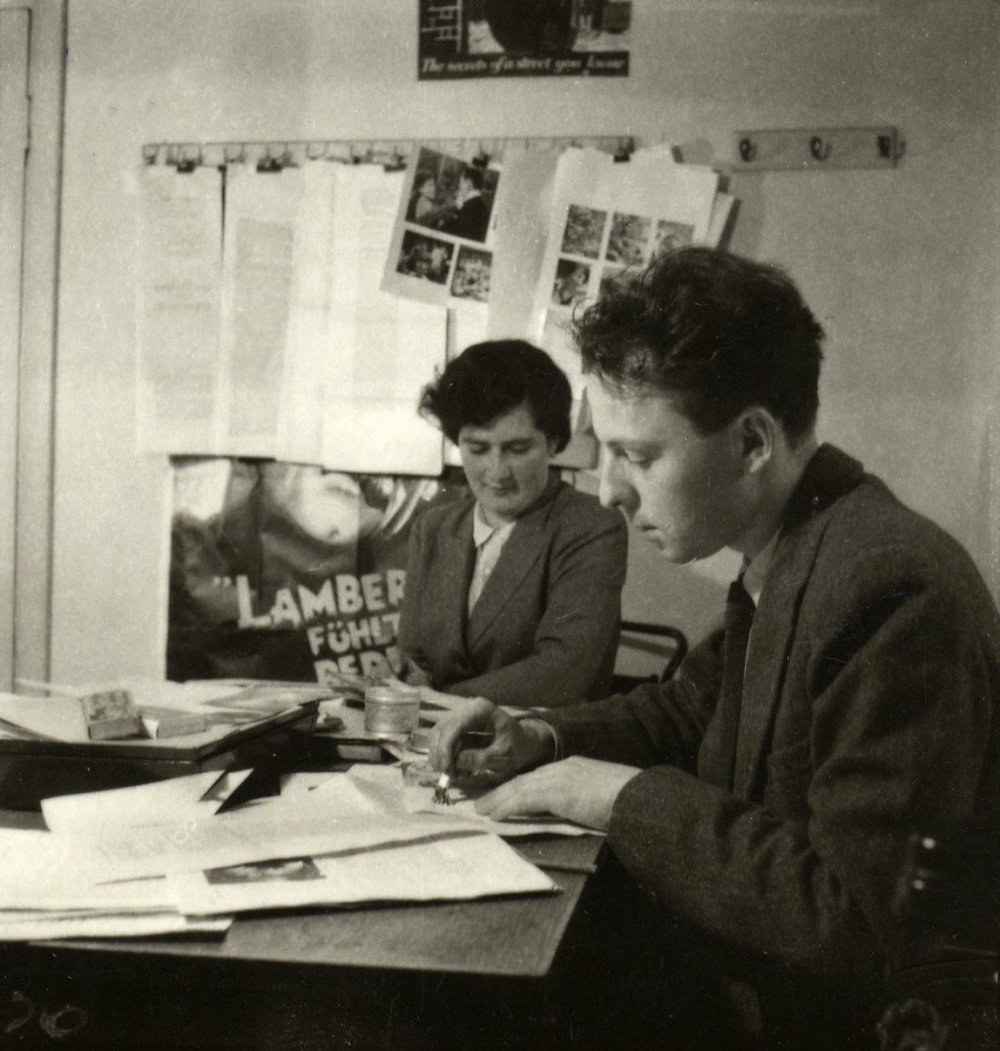
Penelope Houston working on an early issue of Sight & Sound with Gavin Lambert, from whom she officially took over as editor in 1956, and continued in the post until 1990
David Robinson
Critic and festival director; Assistant Editor of Sight and Sound and Editor of the Monthly Film Bulletin in the 1950s
Looking back, what I find most startling is that Penelope Houston was so young – only 26 – when I first met her. True, I was younger, but already she seemed to me a wholly mature, indeed ageless, woman. In all the time I knew her (though it is years now since we last met face to face) she never altered in any respect, except that the hair went from black to grey. Its style never changed, but neither did anything else. Her complexion was ruddy, which I attributed to the amount of time she spent outdoors, on golf and horse-racing. The smoking may have contributed: her raised right hand was rarely without a smouldering cigarette deftly gripped between the two first fingers. She invariably wore suits of never-varying style, conservatively well cut and in a narrow range of darkly restrained blues and greys. She was a distinctive figure.
It was only six years since she had made her name on Sequence. Her association with the magazine began early but was to be intermittent. The dominant influence from start to finish was Lindsay Anderson, who already contributed an article to the primitive, 16-page Sequence One (describing a trip to Paris and his naïve discovery of French cinema of the 30s and 40s) and was the only name to remain on the editorial credits of every one of the magazine’s subsequent 13 issues. Penelope, just turned 20 and reading English, took her place as co-editor, alongside Lindsay and Peter Ericsson, on Sequence Two. It is not recorded how the three met, but she was an obvious asset: academically brilliant, she wrote effortlessly, immaculately and readably, loved cinema, and was a cheerfully willing junior and dogsbody: a note on the back cover of the magazine advises that “Contributors, subscribers and enquirers should write to Penelope Houston at Somerville College, Oxford.”
Her first article, Hollywood Warning, eloquently though prematurely mourned the imminent demise of American cinema: “Hollywood, it seems, is going out with a bang, a last tremendous flourish of inanity. The headlong fall into mediocrity, the lowering of all standards, the emphasis on costs rather than quality (how could a million dollar picture be a failure?), the self-satisfaction, are all signs of the decay which precedes disintegration.” There had been a time, she recalled, when “directors such as Wyler, Wellman, Ford, Lang, Capra, the immortal Chaplin, were given a relatively free hand… Ideally the film company should have the principles of a publisher with a good name to consider, million-dollar box office winners should pay for artistry, there should be no cringing to twelve-year-old audiences”. Hollywood was to survive, all the same – but one knows how she felt. Half a century later, in 2001, she was to congratulate herself on her retirement: “Who wants to spend their days looking at special effects horror films from Hollywood made for 15-year-olds?”
Penelope was credited as co-editor on one more issue, but Sequence’s editorial credits were capricious: with Sequence Four Gavin Lambert joined Ericsson as co-editor, with Lindsay and Penelope as “Associate Editors”. On Sequence Five (Autumn 1948) the editors were Anderson, Ericsson and Lambert, the editorial office was transferred (along with Lindsay and Gavin) to London, and Penelope disappeared entirely from the magazine. This was presumably the interim when she left Oxford to work for the Victoria County History, an episode she never mentioned with any particular interest. She was only to make a brief reappearance in New Year 1950 as assistant editor on Sequence Ten (a good issue, to which a young Indian, Satyajit Ray, modestly submitted an interview with Jean Renoir, then shooting The River in Calcutta).
By this time however the takeover of Sight and Sound was in process, thanks to the arrival in 1949 of the 32-year-old Denis Forman as the British Film Institute’s new director. Forman found the place very much as Kenneth Clark had frankly reported to the Ministry of Information a few years before: “The Film Institute is incompetent and Mr Oliver Bell [its director] a muddle-headed busy-body”. As Bell’s successor, Forman was a phenomenon, his enthusiasm and dynamic energy utterly unrestrained by the prosthetic leg which was a legacy of the Battle of Monte Cassino. Within three years he would give Britain the world’s first National Film Theatre, but his immediate task was to transform the Institute’s dull and dutiful 17-year-old house journal. He did the obvious thing, and poached the Sequence team. Gavin was appointed editor at the end of 1949. Penelope was first credited as assistant in November 1950, but the picture above shows she was already working with Gavin on the August issue, as we can gather from the picture proofs hanging on the wall, including the cover still, from Sunset Boulevard. Lindsay became an enthusiastic contributor, though he loyally sustained Sequence for five more issues, the last three with a new collaborator (the first from Cambridge), Karel Reisz. Reisz in his turn was to be snatched by Forman to programme the new National Film Theatre.
Parenthetically, one wonders if it was part of Forman’s strategy that Gavin and Penelope anticipated their arrival by infiltrating the old Sight and Sound. In the penultimate number Penelope had an article entitled Leading the Blind. It must have been a shock to the habitual readers, with its lucid and persuasive argument for the critic’s role and duty, kicking off challengingly: “The critic is an artist, practising the minor art of criticism, or a frustrated artist driven from the centre of performance to the outer ring of criticism. In either case he owes more respect to his art than to his public: if he fails to consider his public he will not be read, if he fails to consider his art, he will not be worth reading.”
Officially Penelope was appointed editor of Sight and Sound in 1956, but in practical terms she had definitively taken over the role and responsibility from the end of 1953. Gavin had found a sponsor (who was to die shortly after the film was completed) to invest £25,000 in his feature, Another Sky, The film was finished, but hardly seen at the time. Rediscovered on DVD 50 years on, it was hailed by Gus Van Sant as “a rare find… supremely realised” – a nostalgic overstatement, perhaps. The story of a demure governess who arrives in Marrakesh as companion to an elderly lady (Catherine Lacey, from The Lady Vanishes and I Know Where I’m Going!) and is seduced both by the atmosphere and the menfolk of the place, provides a thin disguise for the Moroccan adventures and dreams of Lambert and his older friend Paul Bowles.
Gavin was absent from the BFI throughout the whole period of the production, and after that was distracted by his wooing of Nicholas Ray, both professionally and romantically. This was where (or rather when) I came in. I was working as personal assistant to Basil Wright, mostly occupied with the promotion of World Without End, which he had co-directed with Paul Rotha for UNICEF. The job paid me £4.10s a week – no fortune for London, even in 1953. Basil was a governor of the BFI, however, and proposed me to Denis Forman as a likely assistant to Penelope in Gavin’s absence. She approved; and my wage shot up to £11.
I have no recollection of meeting Penelope for the first time. I think I just sat down and we got on with the job. She was invariably good-humoured, and humorous even in her exasperation with the follies of the Institute’s executive ranks. We shared a small office (this was in Shaftesbury Avenue) with Daphne Hunter, the Sight and Sound secretary and everyone’s confidante. We talked a lot, but mostly about films and the news of the day. She would have chatted eagerly about her two passions, golf and racing, but I wasn’t up to that. She did not say much about herself. I knew that she lived with her family, but she never mentioned them. (Her father was a rubber broker in the city; her mother the daughter of Thomas Marlowe, a famous editor of The Daily Mail from 1899 to 1926. Lindsay and Gavin had met her handsome brother Tom, who survives her, and is the father of her nephew, the nautical Dan Houston).
Karel was in the connecting office. In the coming years I switched between the two departments – editorial and programming – as needs demanded. From late 1953 until his eventual departure for California in 1956, I do not remember Gavin ever being in the office – there would not have been a desk for him in any case. He may have appeared occasionally to join the social hour that was invariable at the end of every working day. Lindsay would burst in around 6, declaiming the slogan from the TV commercial he had been directing that day, to be joined by Karel from the next office, Tony Richardson and latterly Derek Prouse, who was soon to succeed Karel as programmer, and to invent the London Film Festival. The discussions could get heated when it came to the week’s new releases. The only moment I recall clearly is Penelope, cigarette poised, protesting “But Lindsay – you must be fair…”; and the instant fierce riposte, “Penelope! You must NEVER be fair. You will never win that way.” The demonic Prouse, a specialist in Achilles heels, would contribute off-colour sexual allusions, confident that this would always effect Penelope’s embarrassed retreat to paroxysmic coughing and a purple face.
The magazine had to invent formulae to cover Gavin’s continuing absenteeism. He had been appointed with the rather odd title of Executive Editor, with Penelope as Assistant. Throughout 1954 no editor was credited at all, and Penelope was styled ‘Deputy Editor’. In 1955 Gavin reappeared on the credits, now simply as ‘Editor’, with Penelope as ‘Associate’. This persisted until Summer 1956, when Penelope was credited solo as ‘Acting Editor’. Only in the next issue was she finally and formally established as Editor.
This was as it happened an auspicious issue: it included Lindsay’s article Stand Up! Stand Up! which was to transform British film criticism for a generation; other contributors included Gavin, Nicholas Ray, Derek Prouse, Ivor Montagu, Donald Richie, Tony Richardson, Richard Roud and Basil Wright. Penelope thus officially launched herself with style – even though she had been de facto editor for most of the past three years – and continued that way, though there was a mild threat of a defamation suit from the energetic South Bank architect N.W. Engleback when I (with the title of ‘Associate’ from Spring 1957 to Summer 1958) wrote too teasingly about his plans for the new National Film Theatre. To me personally she was an indulgent editor and put up with my incorrigible populism, letting me do articles on Norman Wisdom, the Goons, television, and the then utterly disregarded Laurel and Hardy.
What is striking to recall is that – though her editorial role set her slightly apart – Penelope was part of a pantheon of women who dominated journalistic film criticism in the 1950s. After the death of Richard Winnington, the best of the male survivors were George Stonier (William Whitebait of the New Statesman), Philip Hope-Wallace and Paul Dehn. Of the pre-war women veterans, Sequence Two had firmly disposed of Caroline Lejeune (“Criticism on the Lejeune level would reduce all cinema to a mush”), but Dilys Powell was still loved and regarded. Otherwise the new opinion-makers in the newspaper and periodical press included Nina Hibbin (who could write equally for the Daily Worker and The Lady without compromising her unshakeable Communist faith), Margaret Hinxman, Isabel Quigley, Elspeth Grant, E. Arnot Robertson, Freda Bruce Lockhart, Catherine de la Roche, Elizabeth Sussex (who fearlessly wrote the first book on Anderson, as well as another on the often belligerent or bibulous old Griersonians), Virginia Dignam (a challenging populist on the Morning Star, though she failed in her effort to gain critical recognition for the Confessions of… series) and Denise Silvester Carr, who could encapsulate genuine critical insight into a What’s On proto-tweet.
A number of these contributed to Sight and Sound, to which Penelope most significantly later recruited Jan Dawson, incomparable in British criticism for her dedication and rigour, who gave the Monthly Film Bulletin the authority as record which it retains. It is sad that none of this generation made it into Sight and Sound’s recent poll of the 25 queens of criticism. They did a brave job accustoming their big popular audience to a fast, radically changing and newly international cinema. The old giants – Hitchcock, Ford, King, Lean, Renoir, Clair, Cocteau were still in full activity, but the ladies and their readers had a lot of new names to learn – Kurosawa, Ray, the rehabilitated Buñuel, the rediscovered Ozu and Mizoguchi, Becker, Bresson, Melville, Resnais, Vadim, Chabrol, Truffaut, Godard, Varda, Marker, Malle, Fellini, Antonioni, Kubrick, Siegel, Aldrich, Altman, Polanski, Cassavetes… and the rest. This generation of critics knew Sequence and Sight and Sound and were aware that Lindsay had his eye on them. The male stars – French, Malcolm, Melly, Walker – were only to emerge in the next decade.
The late 60s saw Penelope’s classical approach to criticism – and Sight and Sound with it – widely discounted as old-fashioned and traditionalist. Penelope had firmly closed the doors to aggressive new fashions in film writing which borrowed concepts like structuralism and semantics from other disciplines and media. Time has proved her right: much of the modish critical writing from the period is now unreadable: Penelope’s appreciation, analysis and illumination of Antonioni or Resnais still reads fresh and timeless.
Much more painful however was the new hostility of the three people who had been her first and closest collaborators, mentors and friends – Lindsay, Gavin and Karel. By that time I was much closer to Lindsay than to Penelope, and while I sincerely cherish our uninterrupted 40-year friendship, even then I could not overlook his ruthlessness in promoting his own work. Now on the other side of the fence, he no longer looked for the critical impartiality that had been (somewhat) sacred to Sequence. It was an assumption that This Sporting Life would have the Sight and Sound cover, but there was a ferocious squabble about the choice of still. Daniel Millar’s Sight and Sound review found The White Bus “mean-spirited where it is meant to be generous, and opaque where it is meant to be psychologically subtle”. Gavin Millar concluded his review of If….: “If we can’t read the writing on the wall, perhaps it was because the hand shook a little.” Penelope herself shrewdly diagnosed a lapsus: “There’s a missing generation in this film and it’s behind the camera. Because the parents in it are not parents, they’re grandparents. They’re these authority figures.”
At this point Lindsay convinced Gavin and Karel that she had to go. He and Karel were somehow engineered onto the BFI’s governing board, but optimistic first expectations from this surprising move quickly dissipated when it became evident that their single object was to unseat Penelope. They played their cards badly, irritating the other governors with their insistence. Penelope, supported by the Chairman Sir William Coldstream and the BFI’s director Stanley Reed, remained. Lindsay and Karel resigned soon after, and Penelope was gamely to hold her ground for another 20 years.
After this, all communication ceased. Lindsay could only spit her name, though Karel’s cool middle-European courtesy restrained him. My own generally laudatory obituary of Gavin recalled: “He had an unusual capacity for spite, most notably in his unaccountable treatment of his early comrade Penelope Houston, whom he persistently endeavoured to write out of the history of Sequence and Sight and Sound. As recently as [2002] he contributed to Sight and Sound his recollections of the magazine without mentioning her name, writing off her remarkable 35-year career as editor as a few anonymous years when the magazine lost its way.”
This rejection must have been very painful to Penelope. I believe that she had admired Lindsay more than anyone else in her life and career. She never wanted to talk about it, though she did give a brief but frank account to Geoffrey Nowell-Smith and Christophe Dupin when they were researching their history of the BFI.
As shrewd in her assessment of people as of films, she was herself totally without malice. Her view of mankind was always touched with comedy, and, if the subject came up, the worst she would say, with raised eyebrows, was “Poor old Lindsay.” Her response when I told her that Gavin had died was without unkindness, just a statement of fact: “I can’t say I’m sorry.” By chance our last conversation, this summer, was a hilarious discussion of strategies for her to evade a distinguished Scandinavian historian who wanted to interview her about the falling-out. I treasure her final compliment as we rang off: “I enjoy talking to you. You always make me laugh.” That was an ability she greatly valued in her friends.
Richard Combs
Editor of the Monthly Film Bulletin 1973-91, when it merged with Sight and Sound
Penelope Houston’s article on Michelangelo Antonioni in Richard Roud’s Cinema: A Critical Dictionary is probably the finest piece of writing of hers which I have read: densely argued but at the same time prismatic and crystal-clear. And it is sharpest of all in its writing about Antonioni’s imagery, the way his world, his feelings about that world, are realised on screen. Given that Penelope is now (and probably was even by the time I first knew her, in the early 1970s) regarded as part of an old-fashioned school of film criticism – one more comfortable writing about the literary rather than the visual qualities of a film – this was always one of the most startling qualities of her work.
But her article on Antonioni does more than evoke the architectural aspects of Antonioni’s ‘scene’, and the way these gradually defined the wider world of the 60s – remorselessly spreading from the cinema to advertising – and the emotional tone of the times that went with them (all the shades of entropy, ennui, alienation). What is more striking is the way she captures all the sensations of shift and change that are going on under Antonioni’s mysterious surfaces – that it is not immobility but the opposite that creates all the tension and the problems of interpretation in his work.
She quoted Antonioni himself on the subject: “The problem is to catch a reality which is never static, is always moving towards or away from a moment of crystallisation, and to present this movement, this arriving and moving on, as a new perception.” Partly this movement is defined by the “novelistic” quality of his early films – “the films are novels of behaviour and inference rather than plot or psychological explanation” – and the way this shifts to the painterly qualities of the later films. That’s a brisk way to sum up the change, but Penelope also delved into Antonioni’s other ways of tracing a shift: “Chance arrivals and chance encounters play an enormous part in his films, and his characters are always susceptible to the distractions of an unexpected setting… a wayward glimpse into another life… or an unaccountably ominous presence.”
Perhaps most radical is her summary of the way the drift of these scenes communicates information, or insights, about the characters. “In the airfield sequence of The Eclipse, for instance, the ‘point’ of the relaxed, airily inconsequential mood is that it reaches us through Vittoria [Monica Vitti]; and incidentally discloses more about her character… What the characters are feeling, or what the incidents have to say about them, is secondary; or rather, is communicated less from them to us than, one could almost say, backwards from us to them.”
Antonioni, of course, was not the only director to whom Penelope responded, or the one to whom she responded the most (like other critics of her generation, her writing was fairly director-oriented, although not in a way that justified calling her ‘auteurist’). Her pantheon would also include Satyajit Ray, Miklós Jancsó, Stanley Kubrick, Alfred Hitchcock (guardedly), François Truffaut (mostly). But the above writing on Antonioni also does something else: it evokes the way I got to know Penelope over nearly 20 years when, as head of the Periodicals Department, she was my boss as editor of the Monthly Film Bulletin. ‘Boss’ is a strange word to write, because although she was the last word on departmental matters, she was always reluctant to exercise that role in any sort of day-to-day running of the MFB. It was her task to read the proofs of the MFB every month – mainly, I think, to make sure we didn’t get the department into any legal trouble – and I don’t remember anything more than small disagreements on matters of interpretation or critical attitude.
Penelope, you might say, was a ‘hands-off’ boss – a matter of chance arrivals and chance encounters, perhaps, a coming and going that never defines matters too explicitly. When we changed the format of the MFB in 1982 – to include more diverse material, articles, interviews, etc. – other people wondered if we might inevitably become rivals to Sight and Sound. But our turfs tended to remain separate, with the MFB geared more to issues raised by each month’s new film releases and to other matters that might be called the ‘guerrilla warfare’ of film criticism. Were we the Samuel Fuller to their Satyajit Ray?We sometimes used the same writers (I wrote regularly for Sight and Sound throughout my time at the BFI), but the writing in the two magazines generally seemed to come from different places. I think it’s also fair to say that Penelope felt less need over the years to keep in touch with what we were printing by always reading our proofs. I remember her getting more exercised by the design and layout of our first, newly revised issue (July 1982) – it probably was rather shambolic – than by any dispute over content.
And Penelope’s internal relationships within her department were only a part of her larger relationship with the structure and bureaucracy of the BFI – which I think she also liked to keep on a drifting, coming-and-going basis. She tried to satisfy their demands, their own shifting and often contradictory agenda: their not altogether happy sense that Sight and Sound was the flagship that represented them to the rest of the world, and in particular (most aggravatingly, like an itch they couldn’t quite scratch) to the British film industry. She tried to accommodate them – with perhaps more articles on the economics of the industry and the funding of films than she was truly interested in running.
But she was undoubtedly aware for many years before her retirement of the growing irritation around the issue of how to make Sight and Sound more ‘up-to-date’, or ‘relevant’ or ‘engaged’. Given that she was the editor of the magazine for nearly 35 years, there was undoubtedly an ‘institutional’ quality about Penelope herself, but she was an institution in tension with the larger one – hers was defined as much by her well-known extracurricular passions for gambling and horse-racing.
After Penelope left her post at the BFI in 1990, I had more of a casual, conversational, even collegial relationship with her. She would drop in to the BFI to do research for her book on film archives, and we would exchange views (and general gossip) on the outlook for our two merged magazines. There was an unexpected end point to this. After working as an editor on the new Sight & Sound for a while, I also left the Institute in December 1992. The very next day, I took a plane to Kathmandu (from one Shangri-La to another), to watch some of the filming of Little Buddha, at the invitation of the producer Jeremy Thomas.
While there, I was moved to write to Penelope, the only personal letter I ever sent her, sort of connecting my experience of the Last Days with hers. I hope she received it. It was written on flimsy stationery from the hotel, the name of which I have forgotten although I do remember that the grander establishment where the cast and crew of the film stayed was called the Yak and Yeti. It was the last significant, albeit one-way, communication I had with Penelope, and coming at the end of 20 years of professional exchanges, this personal note also seems to have a little Eclipse-like backwards-flowing quality to it.
Clyde Jeavons
Former curator, National Film and Television Archive
When I joined the BFI as an apprentice film archivist in need of a crash course in film history and aesthetics, my chief inspiration was a Penguin paperback called The Contemporary Cinema, a critical overview of the new post-war European and arthouse cinema imported into the UK’s cultural consciousness by foreign-language distributors such as Connoisseur and Contemporary, and screened at independent venues such as the Academy in Oxford Street (endless queues for the latest Antonioni, I remember), Hampstead’s Everyman and the Curzon in Mayfair. The author’s name resonated with literary and cinematic assonance, and on the back cover of the book, in Penguin’s signature style, was a tiny postage-stamp portrait of a smiling English rose, which I found slightly disconcerting.
When, as a BFI colleague, I first met the real Penelope Houston at a Sight and Sound gathering, the Penguin image evaporated instantly: before me, standing four-square in tweeds and sensible shoes, was a handsome, welcoming, amused-looking woman, a filter-tipped cigarette clamped between her teeth, discussing the odds in the 4.30 at Uttoxeter or some such. I took to her immediately. Like me, she had a get-out clause, a violon d’Ingres: mine was cricket, hers was horse-racing. It was a relief in those zeitgeisty, nouvelle-vague-ish times to find someone for whom film, no matter how important, was not a 24-hours-a-day obsession. Also earning my tacit approval was Penelope’s daily ritual of lunch with one or more colleagues; she especially liked good Chinese. An invitation to join her was usually for a purpose: it was at Poons, off Leicester Square, that she commissioned my first film review for Sight and Sound –- a nervous 1,000 words or so on Billy Wilder’s The Front Page (1974), my mild reservations about which offended a number of Wilder aficionados.
I was further delighted to find that Penelope – despite run-ins with the then Curator of the National Film Archive, Ernest Lindgren – was a supporter of film conservation: for her, film was an authentic art-form which demanded proper preservation, especially one subject to so much ephemeral neglect. (She just objected to Lindgren’s use of the pompous word ‘posterity’, which she likened to Woody Allen’s definition of eternity: “A very long time, especially when you get near the end.”) She liked to leaven Sight and Sound with light-relief diary pieces, and sometimes turned to me for left-field stories from the wacky world of film archiving. One memorable example was the discovery, dredged from the deep-sea wreckage of the Lusitania, of a barnacled reel of silent film (identified as The Carpet from Bagdad, 1915), which was handed to the NFA for inspection. (It survives as a museum curiosity.) Penelope loved the anecdote and gave it headline treatment.
At a more serious level, with the BFI, and particularly Sight and Sound, under attack in the 70s from a fresh breed of film intellectuals – exponents of semiology and structuralism, among other radical departures – who accused the Institute of sticking to conventional and outmoded traditionalist values, Penelope took a typically forthright stand against the invaders. She allowed none of the new thinking to infiltrate the pages of her magazine, and she poured scorn on the writings of these people she regarded as fake, upstart scholars of the art-form she loved. One of her more celebrated put-downs was her brief review of one such lengthy critical study of the films of Howard Hawks: “What the author is trying to say,” she said, “is that Howard Hawks likes to tell a story.” Full stop.
Upon retirement, Penelope took her interest in film archiving a good deal further by researching and writing a now-classic survey of the history and work of the International Federation of Film Archives (FIAF), for which she engaged me as an advisor. My main job seemed to be to persuade her to edit out occasional impish digs at Ernest Lindgren – her view of him didn’t soften – but I will take this opportunity to state that the title of the book, Keepers of the Frame, was my suggestion. At first, Penelope didn’t like it: “Too punny,” she said. “Not enough gravitas.” But as the book proceeded, she began to accept the title: she thought its flippancy would nicely offset the supposed dryness of the subject-matter (which, of course, in her hands turned out to be far from arid). It remains one of the better works about the international archiving movement.
Penelope was an undisputed equal among the finest traditional film historians and critics of her generation: of Lejeune, Powell, Kael, Roud, Milne, French and the like. She brought erudition, wit, perception, style, clarity and a sense of ineradicable enjoyment to her chosen trade. It was said of Sir Christopher Wren: Si monumentum requiris, circumspice (“If you seek his monument, look around”). If you seek Penelope Houston’s, dip into any copy of the peerless film journal she edited for 34 inexhaustible years: Sight and Sound.
Penelope Houston stood up for great cinema (and stood for nothing), she wrote exquisitely about film (but too few books, perhaps?), and if you fancied a flutter on the horses, she was the go-to person for form guidance. Not a bad career combination.
Penelope became reclusive in her latter years. I shall continue to miss her.
Geoffrey Nowell-Smith
Critic and historian; author of a history of the BFI
Penelope was a constant. I first met her in 1961. I had written an article on Antonioni in a student magazine. She had liked it and thought I might make a useful addition to the Sight and Sound stable. To me, a 22-year-old, she seemed very middle-aged, although she was not yet 40. Photographs of her from the early 1950s show her as much the same as when I first met her. But if she had never looked young, she also never seemed to get old, at least until the very end of her life. Same reddish complexion, same shock of black hair, which over time slowly developed some flecks of grey and a strange orange streak (claimed by some wags to be a nicotine stain caused by smoke rising from the cigarettes she had constantly clenched in her teeth while she worked).
And if her looks didn’t seem to change, neither did her manner. The same abrupt judgements, the same slightly archaic verbal mannerisms (“Goody, good,” was a favourite). Her tastes and general ideas of what was good cinema didn’t change much either. Some of her early heroes disappointed her, such as Nicholas Ray, but she remained loyal to most of them and the sort of quality cinema they represented, and to the new crop of directors who emerged in from the mid-1950s onwards: Satyajit Ray, Truffaut (but not Godard), Resnais, Rohmer, Antonioni, Olmi; a few others, mainly European.
Her life followed a steady pattern. She left for work, by car, only after the morning rush hour was over, arriving in central London, whether at the office or for a press preview, at 10.30. She did not like committee meetings at the best of times and was very resentful when Tony Smith took to holding important meetings at the unearthly hour of 10am. Once at the meeting she spent her time studying the racing form book while keeping an ear open in case something came up which affected the magazine. At weekends she played golf. Every year she went to Cannes for the first week of the festival, leaving the second week for Richard Roud to cover. And that, as far as I know, was her life for most of the period when I knew her.
She was a great prose stylist and an excellent, light-touch editor, interfering only delicately, if at all, in the copy supplied by her trusted contributors, and encouraging the same lightness of touch in the interventions by assistant editors on the magazine. Badly written submissions would simply not be published or, if by any chance a commissioned piece was not up to scratch, its author would not be re-invited to write for Sight and Sound again. This ensured that the magazine was consistently readable, but it also meant that contributions from writers who had something to say but said it badly did not get published while some lightweight pieces found their way in which added little or nothing to knowledge of understanding of film.
If she didn’t change, neither did the magazine. It underwent periodic design changes but its format remained much the same, as did the list of loyal contributors. These contributors included film critics from papers such as the Times, the Guardian, the Observer and the FT, which created a kind of loop. Readers of those papers could read brief instant reviews of films as they came out and then lengthier and more considered opinions from the same writers a month or so later. Since in many cases the films in question only reached the provinces, if at all, some time after their London premiere, it was often what was written about the film or its director in Sight and Sound that was most influential in consolidating an ‘art film’ culture across the country.
But if the magazine and its editor didn’t change, the world did. Sight and Sound came under sustained attack from various quarters from the 1960s onwards. To most of these attacks Penelope remained impervious, only occasionally deigning to deliver a magisterial rebuke to her and the magazine’s detractors. Only the breakdown in relations with Lindsay Anderson caused her any personal grief, but when this broke out into open warfare on the BFI Board of Governors in 1970 she successfully weathered the storm. With Sight and Sound’s circulation continuing to rise (it reached a peak of 34,000 in 1974), her position seemed unassailable.
In the mid-1970s the then BFI Director, Keith Lucas, considered asking her to leave the editorial chair, but seems to have lost his nerve at the last minute. His successor, Tony Smith, did not regard a change of editor at Sight and Sound a priority, but he did remove from Penelope responsibility for other aspects of the BFI’s publishing programme.
Jonathan Rosenbaum
Critic and longstanding contributor to Sight & Sound
I hope I can be forgiven for quoting myself in my first collection, Placing Movies: The Practice of Film Criticism (1993): “As I’ve discovered in my own endeavours in editing the prose of Truffaut, Welles and Bogdanovich, the best editing is usually the kind the reader is least aware of, though the supreme masters of this game – who within my experience are probably Penelope Houston and Michael Lenehan – sometimes manage to minimise the awareness of the writer as well.” Lenehan was the main editor for several years at the Chicago Reader, and Penelope’s stint at Sight and Sound was considerably longer. Over two decades later, I can add without hesitation that no editor that I’ve ever worked with has known more and taught me more about the mechanics of prose than Penelope.
But I hasten to add that my indebtedness to her goes far beyond her superb gifts as an editor. I might even say that it was her taste, above all, that drew me to her magazine in the first place, and her determination to acquire an English work permit for me – a process that I recall took the better part of half a year – that enabled me to move to London from Paris in 1974, to serve as assistant editor at Monthly Film Bulletin (under Richard Combs, a supportive boss and fine editor in his own right) and staff writer for Sight and Sound, my first major job anywhere. Although I remained there for only two and a half years (ultimately due to an encroaching, writerly homesickness for the American language that drove me to accept a teaching post in San Diego from Manny Farber), it was the best possible education I could have received anywhere for my subsequent career as a film critic, with the resources of the BFI’s Information Department providing as much nourishment as the benign influence of Penelope (as well as the assistance of such colleagues as Richard, the late Jan Dawson, David Meeker, Tom Milne, Chris Petit, John Pym, Richard Roud and David Wilson, not to mention Penelope’s wonderfully crotchety assistant Sylvia Loeb, among many others. And I should add the name of Tony Rayns, who taught me a lot).
Both then and afterwards, Penelope remained a somewhat controversial figure in the London film scene for a complicated mix of reasons, not least of which were the privileges accrued from having guaranteed state support and her resistance to some of the more radical strains in filmmaking and film criticism at the time. This eventually led to an unjust neglect of her uncommon strengths as both a critic and an editor that has lasted far too long, ignoring such virtues as her sharp intelligence, her nuanced prose, her openness to contributions from strangers with no calling cards apart from their own submissions, and her everyday kindness and geniality (which led her, for instance, to deliver mail every day to David, Richard and me while we were all picketing the BFI’s Dean Street headquarters as union members on strike). It took me longer than it should have to pick up on her shyness and her embarrassment whenever salty language was spoken, which her relative gruffness in manner tended to make less immediately apparent, but her acute sensitivity was an essential part of who she was, professionally as well as personally. This comes through especially in her review of Last Year at Marienbad for Sight and Sound, for me the finest rendering of the singular experience offered by that film that has appeared anywhere.
Michelle Aubert
Ex-deputy curator NFA/BFI and ex-curator French Film Archives (CNC)
I was a junior BFI colleague of Penelope’s between 1973 and 1989, when she headed Sight and Sound with brio and intelligence.
During these times I used to see exceptional film directors, English and foreign, regularly come to talk with her and her colleagues at the BFI. In particular, she and Lindsay Anderson would often go to lunch together. I imagined so many of them as intellectuals, perhaps contemporaries of hers from Oxford and Cambridge, and we could read about them afterwards in the next S&S. What splendid times these were. All seemed so cool and smooth, even on the unforgettable BFI strike!Penelope was always courteous and pleasant with all. I used to observe her natural authority and stature, although I knew little of her life. Elle en imposait [she awed], as we used to say colloquially. At the same time one was absolutely sure that she was a bright, straightforward and fine person.
After I became head of the French Archives (CNC) she came to see me while researching her book on the world’s archive curators. I was very pleased to meet her again in such different circumstances and times.
I hope she had a pleasant retirement and I will always think of her as one of most intelligent women I had the chance to meet in my working life.
Anthony Smith
BFI Director 1979-88
Penelope’s voice is forcefully inscribed in one’s memory. Every syllable, still perfectly audible in one’s mind, rings with an indelible scepticism of all new nostrums, invokes an era of cineasm before the debate-based culture of the last half-century set in. Her tones evoke the era of ‘appreciation’, when film could excite without doctrine, enjoyed unimpeded contact with the emotions. She enjoyed the affectionate respect of all the filmmakers of her day and brought Sight and Sound safely into the new era and the heightened status it enjoys today. Her work has been in one sense partly forgotten but it will be remembered and re-valued the long term.
Pam Cook
Associate Editor of the Monthly Film Bulletin 1985-91
Formidable is the word to describe Penelope Houston. During her tenure as Sight and Sound Editor, she was a striking figure as she strode around brandishing the inevitable cigarette, years of chain-smoking indelibly marked in her nicotine-streaked grey hair. I remember her in masculine tweed suits and brogues, her booming voice resounding through the BFI corridors as if she owned the place which she practically did. Her distinctive style was probably not accidental. As writer, critic and editor she not only held her own, she held sway in a culture dominated by male critics and filmmakers. Dorothy Arzner, one of the few women directors to have a successful career in the Hollywood studio system, adopted a similar sartorial strategy.
It would be easy to view Penelope as a quintessential British eccentric, and interesting to explore how that persona contributed to her impact and legacy. She voiced strong opinions, not just about movies but also about the state of film criticism and the direction of screen education at the BFI. She was robust in her opposition to certain ‘fashionable’ trends in film culture, including the emergence of close textual analysis favoured by many so-called structuralist theorists. As Peter Bradshaw notes in his perceptive Guardian obituary, she considered cinephilia to be myopic and cut off from social experience. Because of my background in film theory, I was no doubt identified in her eyes with such tendencies. This obscured the fact that I agreed with many, though not all, of her firmly-held views, so lucidly and confidently communicated in the pages of Sight and Sound and elsewhere.
Penelope practised her craft at a time when the authority and expertise of the film critic were respected. She took her leadership role seriously and steered Sight and Sound towards its status as a foremost vehicle for informed criticism and debate. Much has been written about her introduction of the journal’s ten-yearly Critics’ Poll, which in a sense crystallises the contested and unstable nature of film criticism itself. Some might view her generation as mired in class privilege and elitism, but Penelope’s work reached out to a broader readership and retains its relevance for today’s deliberations about the function and future of film criticism. A true independent, and a singular person, she stood her ground over more than 30 years of shifting terrain in British moving image culture.
Ed Buscombe
Former Head of Publishing, BFI
Anyone who knew Penelope was familiar with her forthright comments on people and everything else. I remember I once had to go and talk to Lindsay Anderson about a BFI matter – never a pleasant task, since he hated the BFI vehemently. He told me that when he worked with Penelope on Sequence magazine, she often annoyed him, and that he once got so angry with her that he picked up her typewriter and threw it out of the window. Naturally when I got back to the BFI I checked the truth of this tale with Penelope herself. “Oh, bollocks,” she said. “He never did any such thing.”
Penelope wrote two books for me while I was at BFI Publishing. The first was her contribution to the BFI Film Classics, one of the batch of four that launched the series. I was keen for her to write, something she did too little of by the 1990s. We had a list compiled by the Archive’s David Meeker of 360 titles we wanted eventually to commission. Penelope ran her eye down the list and said dismissively that none of them interested her. (These were the all-time greatest classics of cinema!) But I persisted. A few weeks later she said, rather hesitantly, that she might be able to produce something on Went the Day Well?, a British film I didn’t know. I said ‘okay’. A few months later she turned in an almost word-perfect manuscript in her characteristic style: clear, to the point, well-informed, perceptive.
Much later, her career at the BFI seemed to be winding down and the BFI authorities were keen for her to go, but she obstinately refused to pick a day. Exasperated, the Director of the BFI, Wilf Stevenson, asked if I couldn’t find her something to do – a book to write, perhaps? I thought there ought to be a knowledgeable and lucid guide to film archives around the world. (At the time archiving had a high profile, in the BFI and elsewhere, thanks in part to the huge growth of interest in early cinema.) Again, Penelope demurred. There wasn’t much to be said, she stated. I persisted. After a while she said there might be something in it. I suggested she take a tour round the world to visit significant archives, in Australia, America, Uruguay, India, etc. Would the BFI pay? I costed the travel and took it to Wilf, who signed off on it immediately. In the event Penelope did a little travelling but not much. She didn’t fancy the idea of long plane trips without smoking, I think. But she did an excellent job on the book (Keepers of the Frame), as ever. She was never less than professional, informed, occasionally trenchant. I didn’t always agree with her, but she was good to work with on these projects.
Ian Christie
Film scholar and regular contributor to Sight & Sound
One of my earliest memories of Penelope Houston (we only came to use first names much later) was seeing her in the impossibly cramped Sight and Sound office in Dean Street, where I think she sat with shoulder to the sliding door. This was significant, since she rarely faced anyone she was talking to, preferring that they should be behind her or to one side. I doubt if I had the courage to speak to her then, having just been commissioned to write a review of Ken Russell’s Women in Love, probably by Tom Milne. But that tiny office was the basis of one of her favourite anecdotes, recalling how the editor of the USSR’s Iskusstvo Kino had come visiting and asked to see the real office of that journal’s venerable equivalent, not believing that it could be so cramped.
I don’t know if Penelope ever visited the Soviet Union, or indeed wrote about the new Soviet cinema herself, but she ran pioneering pieces by Ivor Montagu and John Gillett. And when I was drawn into a first-hand engagement with Russian cinema by John and the then NFT programmer Ken Wlaschin, she encouraged me to produce an extended feature about my visit with Richard Taylor in 1983, illustrated with our own photographs.
When Gorbachev launched his revolution from above, with Elem Klimov suddenly promoted from disfavour to heading the Filmmakers’ Union, Penelope was keen to reflect this unexpected new development, and commissioned a profile of the charismatic Klimov, accepting my title, ‘Perestroika in Person’. Several years later, in 1988, when close relations with Russia made possible a major exhibition of Eisenstein’s drawings in Oxford, London and Manchester, accompanied by an extended film season at the NFT, I think it was Penelope who encouraged me to write about the emerging new image of Eisenstein. The result was a four-page feature that was also printed separately as an event overview.
I knew of course that many of my colleagues regarded her as a bastion of BFI conservatism, still wedded to an antiquated conception of ‘art’ or ‘quality’ cinema, which we in Colin McArthur’s maverick FAS department were dedicated to dismantling. But my experience of working with her was rather different. She could be contemptuous of what she considered merely modish, but she was also open to innovation wherever it might appear. After I had organised an early Raúl Ruiz retrospective in 1981, she was sufficiently intrigued by this Chilean exile to accept a lengthy report on his tenure as director of the Maison de la Culture in Le Havre, whom I had visited in 1986.
Penelope’s retirement in 1990 marked the end of an era, and created the opportunity for a major re-think of the journal and its offspring the Monthly Film Bulletin, which had developed an independent and distinctive editorial identity that went some way towards covering the blind spots of its senior partner. As I recall, Penelope was openly unconvinced that a monthly schedule for the merged titles was possible, until Philip Dodd demonstrated that it could be done. Certainly there was little love lost between them, although from a contributor’s point of view both were incisive and supportive editors in very different styles.
Her main retirement project, a book about film archiving wittily titled Keepers of the Frame (1994) in homage to the 1942 Hepburn-Tracy comedy, did not receive the attention that might have been expected at a time when archives were coming under scrutiny. Perhaps it came too early, before the impact of the internet and digital were widely felt. Or perhaps it was too polite in its view of the archival world, refusing to court controversy. It is hard to avoid the conclusion that Penelope’s greatest period, certainly as a writer, was the beginning of the 60s, when she wrote both luminously and lucidly about the great landmark films of that pivotal era, especially Resnais’ and Robbe-Grillet’s Last Year at Marienbad, and summed it up elegantly in her Penguin survey The Contemporary Cinema. I can still remember my surprise (but why?) when an au pair showed me passages of exemplary English prose she’d been given, which included an extract from The Contemporary Cinema – a distinction that very few books of film criticism have achieved. And only days ago, an academic contributor to a symposium on ‘turning point’ films singled out Penelope’s Marienbad review as the best single text on that film, unaware, as far as I know, that its author had just left us.
If she had had anything as trite as a motto, it would probably have been something like ‘good writing about good films’. But of course she would have rightly dismissed that as just a cliché. It was, quite simply, a privilege and an education to have been edited by her, and by Tom Milne, in those far from lavish offices where they seemed to be monarchs of all they surveyed.
Editor’s note: this article was originally published on 12 November 2015, without David Robinson’s contribution. We added that on 16 November.
See also
☞ Read Jonathan Rosenbaum on Penelope Houston, and Penelope Houston on Alain Resnais’ Last Year in Marienbad, on our story celebrating female film critics: A pantheon of one’s own: 25 female film critics worth celebrating.
☞ Our eight-decade archive is now accessible via digital subscription. .
-
The Digital Edition and Archive quick link
Log in here to your digital edition and archive subscription, take a look at the packages on offer and buy a subscription.




